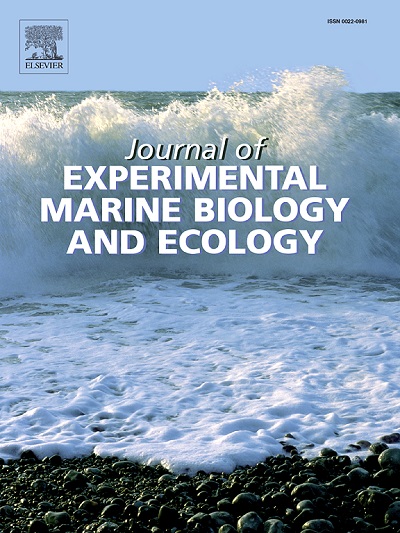Contribution of harbor seal derived nutrients to Saccharina beds assessed using δ15N
IF 1.8
3区 生物学
Q3 ECOLOGY
Journal of Experimental Marine Biology and Ecology
Pub Date : 2024-10-11
DOI:10.1016/j.jembe.2024.152061
引用次数: 0
Abstract
Although seaweed beds along the northern coast of Japan have generally deteriorated, algal beds have remained where nutrients are continuously supplied from inflows and/or animal aggregations. Here, we show that NH4-N assimilated in kelp (Saccharina angustata) was derived from harbor seals (Phoca vitulina stejnegeri) on the reef of Cape Erimo, Hokkaido which is the largest breeding ground of this species in Japan, using isotopical and molecular techniques. Coastal waters of Erimo area generally have high nutrient concentrations in winter and low nutrient concentrations from spring to autumn. On the other hand, in the reef area of Cape Erimo where the harbor seal haul-out occurs, high concentrations of DIN and DIP, high contribution of NH4-N to DIN continued after winter, and environmental DNA analysis revealed that seal-derived DNA was simultaneously high. The mean δ15N value of S. angustata in the reef area of Cape Erimo was 8.8 ± 0.9 ‰ (n = 14) which was enriched compared to the mean δ15N value of 6.9 ± 0.6 ‰ (n = 75) sampled from other coastal areas of Erimo. The mean TN content of S. angustata in the reef area of Cape Erimo was also 2.0 ± 0.1 % (n = 14), which was higher than the mean TN content of 1.6 ± 0.2 % (n = 75) sampled from other coastal areas of Erimo. The thallus size of S. angustata collected from the reef area of Cape Erimo was larger than samples collected from the other sampling points where the thallus size decreased from June to August. These results indicated that the harbor seal was a significant source of NH4-N absorbed by kelp, acting as a vector for supplying nutrients to nutrient poor coastal ecosystem probably through excrement and detrital material from prey items. Thus we conclude that harbor seals, as the top predator of the food web, play an important role as a bottom-up control in the ecosystem.
利用 δ15N 评估港海豹衍生营养物质对 Saccharina 海床的贡献
虽然日本北部沿海的海藻床普遍恶化,但在营养物质不断由流入和/或动物聚集提供的地方,藻床仍然存在。这里,我们利用同位素和分子技术表明,海带(Saccharina angustata)中同化的 NH4-N 来自北海道襟裳岬珊瑚礁上的港海豹(Phoca vitulina stejnegeri),该珊瑚礁是该物种在日本最大的繁殖地。襟裳岬地区的沿岸水域通常冬季营养浓度较高,春秋两季营养浓度较低。另一方面,在港海豹出没的襟裳岬礁石区,DIN 和 DIP 浓度较高,NH4-N 对 DIN 的贡献率较高,而且环境 DNA 分析表明,海豹源 DNA 同时较高。埃里莫角礁石区 S. angustata 的平均 δ15N 值为 8.8 ± 0.9 ‰(n = 14),与埃里莫其他沿海地区采样的平均 δ15N 值 6.9 ± 0.6 ‰(n = 75)相比有所富集。埃里莫角珊瑚礁区 S. angustata 的平均 TN 含量也为 2.0 ± 0.1 %(n = 14),高于埃里莫其他沿海地区取样的平均 TN 含量 1.6 ± 0.2 %(n = 75)。在埃里莫角珊瑚礁区采集到的 S. angustata 苔藓尺寸大于其他采样点采集到的样本,而其他采样点的苔藓尺寸在 6 月至 8 月期间有所减小。这些结果表明,港海豹是海带吸收 NH4-N 的一个重要来源,可能通过排泄物和猎物的碎屑为营养贫乏的沿海生态系统提供营养。因此,我们得出结论,港海豹作为食物网的顶级捕食者,在生态系统中发挥着自下而上的重要控制作用。
本文章由计算机程序翻译,如有差异,请以英文原文为准。
求助全文
约1分钟内获得全文
求助全文
来源期刊
CiteScore
4.30
自引率
0.00%
发文量
98
审稿时长
14 weeks
期刊介绍:
The Journal of Experimental Marine Biology and Ecology provides a forum for experimental ecological research on marine organisms in relation to their environment. Topic areas include studies that focus on biochemistry, physiology, behavior, genetics, and ecological theory. The main emphasis of the Journal lies in hypothesis driven experimental work, both from the laboratory and the field. Natural experiments or descriptive studies that elucidate fundamental ecological processes are welcome. Submissions should have a broad ecological framework beyond the specific study organism or geographic region.
Short communications that highlight emerging issues and exciting discoveries within five printed pages will receive a rapid turnaround. Papers describing important new analytical, computational, experimental and theoretical techniques and methods are encouraged and will be highlighted as Methodological Advances. We welcome proposals for Review Papers synthesizing a specific field within marine ecology. Finally, the journal aims to publish Special Issues at regular intervals synthesizing a particular field of marine science. All printed papers undergo a peer review process before being accepted and will receive a first decision within three months.

 求助内容:
求助内容: 应助结果提醒方式:
应助结果提醒方式:


